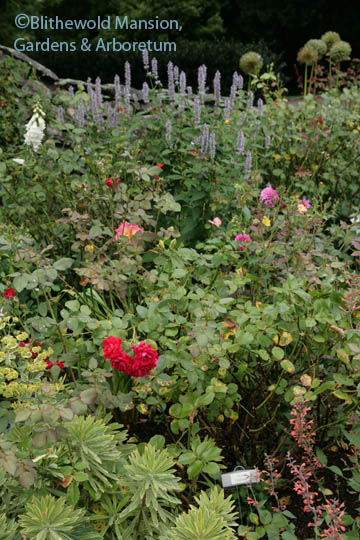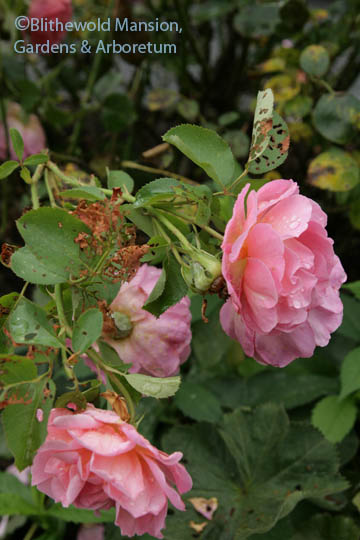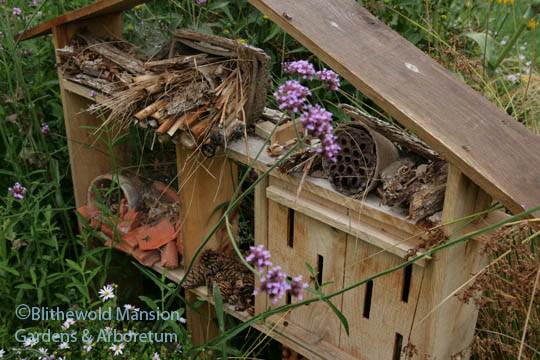Live and let live
 I’ve gotten a couple of questions in the last week or two about what we do in the gardens to manage pests and diseases. Although a lot of you already know the answer, I don’t seem to mind repeating it for anyone who doesn’t. The short answer is: Nothing! We do not use any kind of chemical pesticides or fungicides for the sake of our own health as well as that of our volunteers, visitors, members, camp kids, pollinators, beneficial insects, birds and other wildlife. (That said, I believe Dan has sprayed some sort of bunny deterring pepper concoction in the Vegetable Garden. Not that it has worked. Also, the trees, shrubs, and lawns are managed differently.)
I’ve gotten a couple of questions in the last week or two about what we do in the gardens to manage pests and diseases. Although a lot of you already know the answer, I don’t seem to mind repeating it for anyone who doesn’t. The short answer is: Nothing! We do not use any kind of chemical pesticides or fungicides for the sake of our own health as well as that of our volunteers, visitors, members, camp kids, pollinators, beneficial insects, birds and other wildlife. (That said, I believe Dan has sprayed some sort of bunny deterring pepper concoction in the Vegetable Garden. Not that it has worked. Also, the trees, shrubs, and lawns are managed differently.)
The long answer is: In the gardens, we try to keep plants healthy and stress-free by providing them with fertile soil (easy because the soil here is lovely) and adequate water. We amend the soil with compost, both our own and the biosolid and yardwaste mix (top grade and certified pathogen-free) made by Bristol’s composting facility, and we mulch with shredded leaves and buckwheat hulls, both of which add organic matter and aerate the soil as they break down.
We welcome insects, and the birds that eat them. We do minimal clean-up of seedheads and stalks in the fall to leave some habitat and cover for birds and insects over the winter. We have even started construction on an insect apartment house. (They’re all the rage in Europe.) It’s made of white oak, faces south for winter warmth, and we will continue to fill it with bits and bobs that that will provide nesting sites for solitary bees, lacewings, spiders, and any other critters that might find it cozy. The section with the slots is intended as a butterfly shelter but I read recently that they don’t really use those. Looks cool though.
 It’s the visitors to our Rose Garden who have the hardest time believing that we don’t spray fungicides, etc. Honestly, we don’t need to. I know I’ve said this a million times already but here it is again: along with choosing disease-resistant roses, and giving them great soil and adequate water (about an inch per week), we also fertilize them 3 times over the season (in April as they break, in May/June just before peak, and in August for their last flush) using a slow release organic granular fertilizer (Espoma Bulb-Tone); we rake out the spotty leaves twice weekly; and we hand-pick Japanese beetles. But the real reason the roses look healthy is because there are other beautifully blooming plants in that garden that draw everyone’s attention away from a few yellow or lacy leaves.
It’s the visitors to our Rose Garden who have the hardest time believing that we don’t spray fungicides, etc. Honestly, we don’t need to. I know I’ve said this a million times already but here it is again: along with choosing disease-resistant roses, and giving them great soil and adequate water (about an inch per week), we also fertilize them 3 times over the season (in April as they break, in May/June just before peak, and in August for their last flush) using a slow release organic granular fertilizer (Espoma Bulb-Tone); we rake out the spotty leaves twice weekly; and we hand-pick Japanese beetles. But the real reason the roses look healthy is because there are other beautifully blooming plants in that garden that draw everyone’s attention away from a few yellow or lacy leaves.
In the gardens, we live and let live. Don’t you?

